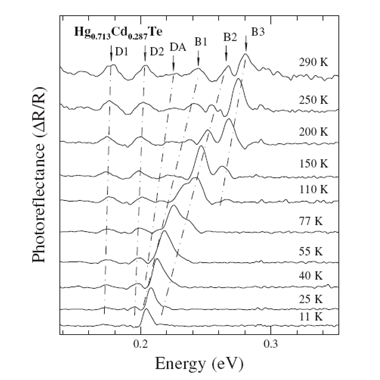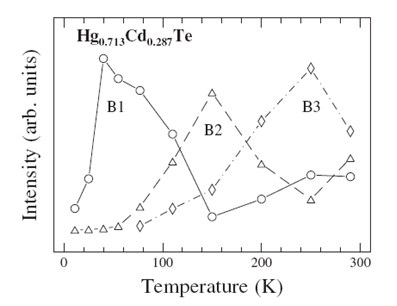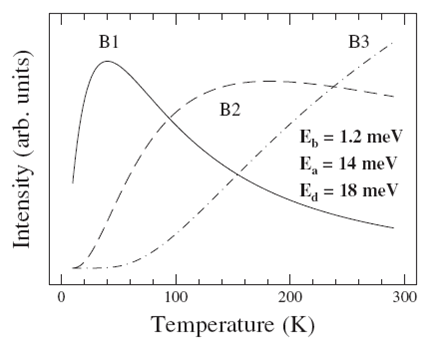Photoreflectance (PR) is a modulation spectroscopy having been employed widely in characterizing semiconductor electronic band structures. Its derivative nature suppresses uninteresting background and emphasizes structures located at the energy range of interband transitions and other weak features.
In this work, temperature-dependent (11-290K) infrared photoreflectance (PR) measurements are performed on as-grown arsenic-doped HgCdTe epilayers in a midinfrared spectral region. Figure 1 depicted the temperature dependent PR spectra for the HgCdTe samples. The evolution of individual PR features with temperature is traced out by dash-dots and marked with D1, D2, DA, B1, B2, and B3, respectively. It is obvious that the main PR features are contributed in turn by B1, B2, and B3 as temperature rises. Therefore, they cannot be attributed solely to band-band but may be dominated by either inter-band or below-band process at a particular temperature. To get a closer view of the lineshape evolution, curve fittings of PR spectra are given in Fig.2. Main PR features near bandedge manifest clear evolution of lineshape with temperature, of which the fittings identify besides a band-band process several below-gap processes. Figure 3 plots the main PR features’ intensities against temperature. Analyses show that these features are due to photomodulation-induced screening of donor-acceptor pairs and photomodulation of band-impurity and band-band reflectance, their intensities correlate to the joint concentration of the involved energetic states. The calculated temperature dependences of the intensities are shown in Fig.4. The intensities of B1, B2, and B3 can be obtained by
Eb denotes the binding energy of donor-acceptor pair, and Ed and Ea represent the thermal ionization energies of donor and acceptor, respectively. The intensities of B1, B2, and B3 can be estimated by assuming that the equilibrium concentration of holes from acceptors follows
exp(-Ea/2KbT)relation, while electrons form thermal ionization of donors follow the standard calculation of statisical mechanics of hydrogen atoms. The simulation mimics the enhancement of B1 and B2 with temperature quite well, with the maxima showing at similar temperatures as manifested by experimental data.
Analyses show that these features are due to photomodulation-induced screening of donor-acceptor pairs and photomodulation of band-impurity and band-band reflectance, their intensities correlate to the joint concentration of the involved energetic states. These results indicate that the main PR features are not a BSR (pure back-surface reflection) effect but related to shallow impurities. This is clear contrast to the previous below-gap PR study but is consistent with the knowledge that in bulk semiconductors the contribution of the absorptive component to band-band PR process is negligible. Temperature-dependent infrared PR may be a right optical spectroscopy for identifying impurity levels in semiconductors such as HgCdTe with high-density impurities.

Fig.1 PR spectra for HgCdTe sample in identical intensity scale but different offsets.

Fig.2 PR and PL spectra for Hg0.713Cd0.287Te sample at (a) 11K, (b) 40K, ? 110K, and (d) 150K, overlaid by fitting curves. The critical-point positions are marked by arrows and labels.

Fig.3 Intensity vs temperature in open circles, triangles, and diamonds for B1, B2, and B3 PR features, respectively. Lines connect the individual sets of points to guide the eyes.

Fig.4 Simulation of the intensity vs temperature for B1, B2, and B3 PR features, respectively.
This work published on Appl. Phys. Lett. 93,131914 (2008) |